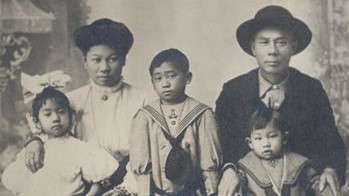Throughout United States history, certain laws have been passed to restrict immigration. The first major law to greatly restrict immigration was passed in 1882. It is known as the Chinese Exclusion Act. Why did Congress pass the Chinese Exclusion Act of 1882?
Many Chinese people were fleeing China by the mid-1800s. They left their country due to economic hardship and natural disasters such as floods and droughts. They looked for work in different parts of the world. For many years after the Gold Rush began in 1848, a lot of people from China arrived in California. They were hoping to work in gold mines and get rich quickly. Many of these Chinese immigrants soon realized there was little to no gold to be found, so they took difficult, dangerous jobs building the Transcontinental Railroad. A lot of Chinese immigrants also worked in restaurants, stores, and laundry services in California’s mining towns.
Life for Chinese immigrants was very tough. People in the United States discriminated against Chinese immigrants, with some people acting violently toward them. In the 1870s, the treatment of Chinese immigrants got worse. Some American workers thought Chinese immigrants were taking their jobs. They blamed Chinese immigrants for their own economic hardships. They did not view Chinese people as equal to them. Violence between Chinese immigrants and American-born workers increased. During this time, lawmakers in California and the nation were trying to pass laws restricting Chinese immigrants. Finally, Congress passed the Chinese Exclusion Act, even though Chinese immigrants only made up .002 percent of the nation’s population. Under this restrictive act, the only Chinese people allowed to enter the United States were students, teachers, diplomats, and tourists.
In 1892, when the Chinese Exclusion Act was set to expire, it was extended for another 10 years under a new law called the Geary Act. The Geary Act added restrictions, like requiring Chinese immigrants living in the U.S. to register for special identification papers. Chinese people caught without their papers were usually sent back to China. Ten years later, the Geary Act was extended permanently. Then, starting in 1924, all immigration from China was banned under the Immigration Act of 1924. In fact, this act didn’t just ban Chinese immigrants. It banned immigrants from all of Asia.
The Chinese Exclusion Acts were finally lifted in 1943. The United States lifted these acts to strengthen its alliance with China during World War II. But even after the ban was lifted, only 105 Chinese people could get visas per year. The U.S. continued this limit on immigration from China until 1965, when new immigration policies were created. The new policies ended the restriction of immigration based on ethnicity, and they focused on reuniting family members and allowing skilled workers into the country. Soon after, the number of people immigrating from China grew rapidly.
The Chinese Exclusion Acts greatly limited the growth of the Chinese population in the United States for a long time. But Chinese immigrants and their descendants have made a huge impact in the country. Chinese Americans have served in Congress, created award-winning and popular American movies, represented the U.S. in the Olympics, and much more.









